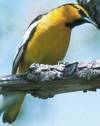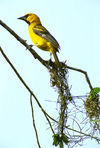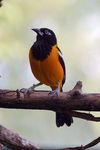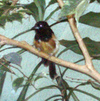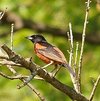Genus Icterus
Black-backed oriole - Its natural habitats are subtropical or tropical moist lowland forests and subtropical or tropical moist montanes.
Orange Oriole - Its natural habitats are subtropical or tropical dry forests and heavily degraded former forest.
Orange-crowned Oriole - Its natural habitats are subtropical or tropical dry forests, subtropical or tropical moist lowland forests, and heavily degraded former forest.
Martinique Oriole - Its natural habitats are subtropical or tropical dry forests, subtropical or tropical moist lowland forests, subtropical or tropical mangrove forests, and plantations .
Bullock's Oriole - Adults have a pointed bill. The adult male is orange on the underparts, face and rump with black everywhere else; they have a white wing patch. The adult female is grey-brown on the upper parts, dull yellow on the breast and belly and has wing bars.
Epaulet Oriole - The Epaulet Oriole is a species of bird in the Icteridae family. The Moriche Oriole, formerly considered a distinct species is now placed herein as a subspecies.
Yellow-backed Oriole - It is found in Belize, Colombia, El Salvador, Guatemala, Honduras, Mexico, Nicaragua, Panama, and Venezuela.
Nelson's oriole - Adults have a pointed bill and white wing bars. The adult male has an orange head with black on the face and throat; they are black on the back, wings and tail, orange on the underparts. The adult female is olive-green on the upper parts, yellowish on the breast and belly.
Greater Antillean oriole - The Greater Antillean Oriole was formerly included with Black-cowled Oriole but was split in 1999.
Baltimore Oriole - The Baltimore Orioles, a Major League Baseball team in Baltimore, Maryland, were named after this bird. It is also the state bird of Maryland.
White-edged Oriole - Its natural habitats are subtropical or tropical dry forests and subtropical or tropical moist lowland forests.
Black-headed oriole - The male of the species has a black hood, mandible, and throat, as well as a black tail. Wings are black, but the remiges and retrices are fringed with white. The secondary coverts form yellow epaulets. The back and vent are yellow washed with olive, and the underside is almost uniformly yellow. Females of this species have a slightly more olive nape and back than the males. The adult female’s plumage is similar to the juvenile plumage; however, unlike adults, the wings are dull brown instead of black. In general, immature specimens have the hood; wingbars; remiges; and epaulets of adult specimens. The first-basic plumage retains the darker, greener coloration of the juvenile plumage, however. Molting generally occurs in early autumn, though some specimens have been noted to molt as early as June.
Altamira oriole - At 25 cm and 56 grams, this is the largest oriole of the Icterus genus. This bird nests in open woodlands. The nest is a very long woven pouch, attached to the end of a horizontal tree branch, sometimes to telephone wires.
Troupial - The Venezuelan Troupial is fairly large in size, with a long tail and a bulky bill. It has a black head and upper breast. The feathers on the front of the neck and upper breast stick outward, making an uneven boundary between the black and the orange of the bird's lower breast and underside. The rest of the orange color is found on the upper and lower back, separated by the black shoulders. The wings are mostly black except for a white streak that runs the length of the wing when in a closed position. The eyes are yellow, and surrounding each one, there is a patch of bright, blue, naked skin.
Campo Oriole - It is found in Argentina, Bolivia, Brazil, Colombia, Ecuador, Guyana, Paraguay, and Peru.
St. Lucia Oriole - Its natural habitats are subtropical or tropical dry forests, subtropical or tropical moist lowland forests, subtropical or tropical moist shrubland, and heavily degraded former forest. It is threatened by habitat loss.
Jamaican Oriole - Its natural habitats are subtropical or tropical moist lowland forests, subtropical or tropical moist montane forests, and heavily degraded former forest.
Bar-winged Oriole - Its natural habitats are subtropical or tropical moist montanes and heavily degraded former forest.
Yellow-tailed Oriole - The Yellow-tailed Oriole is 22-23 cm long and weighs 70 g. It is mainly yellow with a black back, lower face and upper breast. The wings are black with a yellow epaulet and the tail is black with yellow sides. This is the only oriole with prominent yellow in the tail, hence the species’ name. The sexes are similar, but young birds have the black on the back and tail replaced with olive-green.
Yellow Oriole - Yellow Oriole breeds in northern South America in Colombia, Venezuela, Trinidad, the Guianas and parts of northern Brazil, . The Yellow Oriole is a bird of open woodland, scrub and gardens. Its nest is a 40 cm long hanging basket, suspended from the end of a branch. The normal clutch is three pale green or grey eggs.
Montserrat Oriole - It inhabits a small area on the island of Montserrat in the Lesser Antilles of the West Indies, and is the national bird of this British territory. It is threatened by habitat loss, and has been classified by BirdLife International as Critically Endangered, with a current estimated population of between 200 and 800. Much of its habitat was destroyed by deforestation, Hurricane Hugo and the volcanic activity between 1995 and 1997.
Scott's oriole - It is primarily found in the Southwestern United States and south to Baja California Sur and central Mexico.
Spot-breasted oriole - It is found in Costa Rica, El Salvador, Guatemala, Honduras, Mexico, Nicaragua, and the United States.
Black-cowled Oriole - It is found in Belize, Costa Rica, Guatemala, Mexico, Nicaragua, Panama, and possibly Honduras.
Streak-backed Oriole - It is primarily found in the west coast of Mexico, but is a very, very rare visitor in the Southwestern United States.
Orchard Oriole - This species is 6.3 inches long and weighs 20 g. The bill is pointed and black with some blue-gray at the base of the lower mandible . The adult male of the nominate subspecies has chestnut on the underparts, shoulder, and rump, with the rest of the plumage black. In the subspecies I. s. fuertesi, the chestnut is replaced with ochre . The adult female and the juvenile of both subspecies have olive-green on the upper parts and yellowish on the breast and belly. All adults have pointed bills and white wing bars. One-year-old males are yellow-greenish with a black bib.
Black-vented oriole - Its natural habitats are subtropical or tropical dry forests, subtropical or tropical moist lowland forests, and subtropical or tropical moist montanes.

